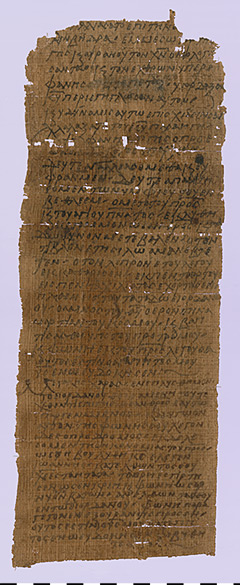P. 11633
„Rejoice in the Lord all the earth.“ Many hymns have been handed down from the ancient Christian context. Sometimes they are even related to specific occasions. Certain festivals of the church year already had their liturgical hymn texts even in the early days of Christianity. One such example has been preserved on this papyrus from the Berlin Papyrus Collection.
The narrow papyrus sheet is complete at both sides and the bottom, but broken off at the top. The text has been written in a rather neat script, clearly sloping to the right, which can be dated to the late 8th or 9th century AD. The initial letters of lines 8 and 29 are enlarged and project into the left margin. This should make it clear that a new section is beginning here. This separation is additionally marked at the end of line 28, where a colon and a curved bow have been placed to fill the rest of the line. However, since an unknown number of lines are no longer present at the beginning of the text, it remains uncertain whether the preserved text belongs to a hymn with several sections or at least whether a second hymn begins in line 29. Within the text, sense units have been separated by superscript slashes or a tick to facilitate reading or singing of the hymns. There are occasional corrections above the lines. Spelling and grammar are poor, making it difficult to understand the text and forming a clear contrast to the neat script. As is often the case in Christian texts, the nomina sacra have been shortened and a line drawn across the letters.
The baptism of Jesus Christ in the Jordan is the topic of the hymns. Within the church year it has been celebrated with the feast Theophany (Epiphany – appearance of the Lord) on the 6th January. The text is based on the New Testament accounts of this event and uses several verses from the Old Testament Psalms. In the incompletely preserved first section, the text begins with the arrival of Jesus Christ at the Jordan and his joy at his impending baptism. Above all, his majesty and glory are celebrated. In the second section, the congregation is called to rejoice and be glad about this event. The birth of Jesus Christ is first recalled and then reference is made to various miracles from his later life: the turning of water into wine at the wedding in Cana, the healing of a blind man in the pool of Siloah, the healing of a leper and the feeding of the five thousand with five loaves of bread. At the end of this section, the narrative thread of the first section is resumed and the baptism by John and God’s recognition of Jesus as Son is described. The last section once again gives a rather sober account of the events at the Jordan. This contrast to the first two sections, the repetition of details and the clear separation of the last section from the rest of the text described above make it conceivable that a new hymn is discernible here.
It is possible that the leaf was used as an amulet, as might be indicated by the traces of folding. Both hymns show that Epiphany was already celebrated as the feast of baptism in Egypt of that time. In the first hymn in particular, the richness of this feast also becomes clear when various miracles are mentioned and associated with this feast.
These Christian hymns were on display in the special exhibition „Soundscapes – Music in Ancient Egypt“.



